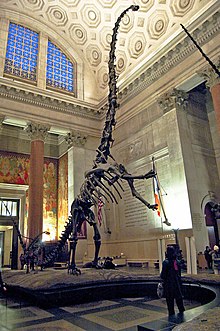Barosaurus
|
Barosaurus Temporal range: Late Jurassic, 152–150 Ma |
|
|---|---|
 |
|
| Mounted skeleton in rearing posture with a juvenile Kaatedocus siberi, American Museum of Natural History | |
| Scientific classification | |
| Kingdom: | Animalia |
| Phylum: | Chordata |
| Class: | Reptilia |
| Clade: | Dinosauria |
| Order: | Saurischia |
| Suborder: | †Sauropodomorpha |
| Clade: | †Neosauropoda |
| Family: | †Diplodocidae |
| Genus: |
†Barosaurus Marsh, 1890 |
| Species: | †B. lentus |
| Binomial name | |
|
Barosaurus lentus Marsh, 1890 |
|
Barosaurus (/ˌbæroʊˈsɔːrəs/ BARR-o-SAWR-əs) was a giant, long-tailed, long-necked, plant-eating dinosaur closely related to the more familiar Diplodocus. Remains have been found in the Morrison Formation from the Upper Jurassic Period of Utah and South Dakota (and possibly the Tendaguru Formation of Tanzania). It is present in stratigraphic zones 2-5.
The composite term Barosaurus comes from the Greek words barys (βαρυς) meaning "heavy" and sauros (σαυρος) meaning "lizard"; thus "heavy lizard".
Barosaurus was an enormous animal, with some adults measuring more than 26 meters (85 feet) in length and weighing more than 20 metric tons (22 short tons). There are some indications of even larger individuals, probably over 50 meters long and with a mass exceeding 120 tonnes making it possibly the largest known dinosaur.Barosaurus was differently proportioned than its close relative Diplodocus, with a longer neck and shorter tail, but was about the same length overall. It was longer than Apatosaurus, but its skeleton was less robust.
Sauropod skulls are rarely preserved, and scientists have yet to discover a Barosaurus skull. Related diplodocids like Apatosaurus and Diplodocus had long, low skulls with peg-like teeth confined to the front of the jaws.
...
Wikipedia
